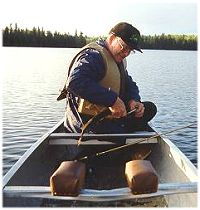 |
- That the border area between the US and
Canada in the Boundary Waters Canoe Area and Quetico Provincial Park is nearly 150 east to west. Look at map here. - The most controversial of all federally designated wilderness areas? Ya you betcha! The combination of loggers seeking old growths tall pines, the resort and cabin owners, the motorboat
and snowmobile users, bush pilots and the folks who wanted to fly-in, and the wilderness and solitude seekers, all who wanted it their way. The 1964 and 1978 Wilderness Acts ended much of that and made the area for wilderness
canoeing. The 1964 Wilderness
Act Public Law 88-577 - September 3, 1964 and the
BWCA Wilderness Act
1978 Public Law 95-495 - Oct. 21, 1978.
|
- The earliest recorded white folk explored the area about 1660. Soon after that came the "Voyageurs" French and other northern Europeans, exploring and exploiting the
resources of the area. They traded manufactured goods for furs well into Canada. The Native People trapped and traded furs with these people, who were eventually pushed out and made "civilized" by the white people.
- The Boundary Waters is about a
million acres in size, and experiences over 200,000 visitors each year. That's why there is a permit and party size regulation. With the idea of solitude in mind, the BWCA is a great place to escape to.
From the office phones, buzzing highways, busy family and work schedules, and those looming deadlines. Mechanized items like motors, personal watercraft, buildings, and roads are not permitted.
- The first 10 days of June and the last two weeks of August is traditionally when the best weather conditions exist. The early days of June are usually sunny,
warm and calm, luckily the bugs haven't declared a full blown invasion yet. While the last week or two of August is hot during the day and cool at night, the bugs have died off and the waters are still really nice and warm for swimming.
Plan your trip during a full moon if you want great fishing.
- The BWCA has an 80-year history of
recreational use. This area became one of the first parts of Minnesota extensively
served by resorts. The 1920s and 1930s, roads made the area accessible and ushered in a period of rapid growth in the
resort industry. Minnesota enjoyed large popularity on the nationwide resort recreation
market. Visitors came for the adventure.
- Motorboats were used in the BWCA as
early as 1922. Now banned but on a few large periphery lakes, canoes rule the water. Skiers and dogsleds slip through the woods during the winter.
- The first regulation of motorboat
use came in 1948, when the US Forest Service management plan for the BWCAW called for motorboats to be
restricted to areas where their use was well established.
- Snowmobiles had been allowed in
certain areas of the BWCA until September 8, 1976.The first snowmobile use came to
the BWCA about 1950. Snowmobiles are now only allowed on lakes or routes where motor boats are allowed. One of the last uses of the snowmobile was a large rally at Dorothy Molter's place on knife Lake. See pictures on her Web site at:
http://www.canoecountry.com/dorothy or purchase the book/biography of Dorothy Molter, aka "Root Beer Lady" at our
bookstore.
- There are four major fish species you will find swimming the BWCA and Quetico Park lakes. Northern pike, smallmouth bass, walleye, and lake trout. Some areas
surrounding Ely, Minnesota have muskie, largemouth bass and crappie.
- Logging in the BWCAW began about 1893 named the "era of tall pine logging." Rafting and stream driving moved the logs from
the interior to the mills or railheads at the periphery. Several railroad portages
like Four Mile Portage and Prairie Portage near Ely, Minnesota, transported logs between
lakes. Well over 2 billion board feet of white and red pine was harvested By 1930. Want to learn more about the logging and the ecological history of the region? Read "Lob Trees in the Wilderness"
you can purchase the book in our bookstore. |